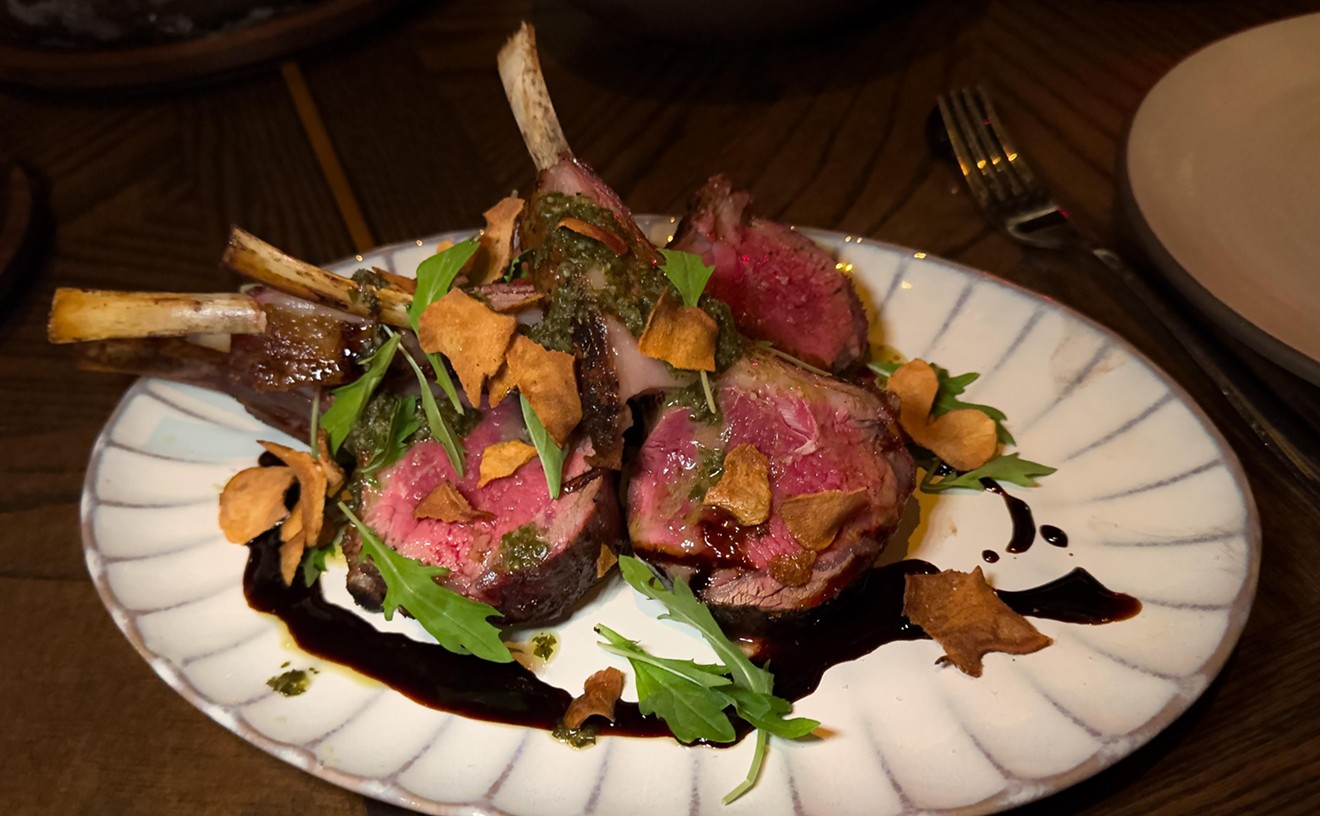But two factors are changing the Asian-dining landscape in the Valley. First, diners are growing increasingly bold and sophisticated. After all, when's the last time someone you know ordered the won ton soup, egg roll and chow mein family dinner for four at a Chinese restaurant? Second, the Valley is growing more ethnically diverse. Take a drive on the west side and look at the Asian markets sprouting up everywhere. Their customers are unlikely to be native Arizonans, and most aren't scanning the aisles for Wonder bread. In response to both opportunity and demographics, Vietnamese and Korean restaurants are popping up with unexpected frequency. Their patrons? Adventurous diners hungry for new ethnic thrills, and natives craving a taste of the old country. I can't say for sure how much Pearl of Asia, which features the dishes of South Vietnam, will make Valley life more agreeable to homesick members of the Vietnamese community. I do know, though, that it's a boon to anyone looking for off-the-beaten-path 1990s Asian ethnic treats at 1970s prices.
One definite plus is looks: Pearl of Asia perches several rungs above the average ethnic shack. No Formica-topped tables with paper-napkin dispensers here. Instead, diners are greeted by pink-linen tablecloths and aqua napkins. A large fountain made from a rugged pile of stones gurgles peacefully in the middle of the room. A few framed paintings depicting scenes of Vietnamese life and a large mirror provide wall adornment.
Vietnamese food is somewhat lighter and less heavily seasoned than other Asian fare. Nothing is spicy-hot. Many dishes are accompanied by platters of greenery--lettuce, cilantro, mint--for munching and wrapping. Just about everything except desserts gets dipped into bowls of distinctive fish sauce, a tangy, salty delight. And just about every dish bursts with flavor.
Take the superb Vietnamese crepes. This huge, sizzling, right-out-of-the-skillet appetizer comes stuffed with whole shrimp and pork. When the waiter brought out a second platter, I told him we'd already been served. He smiled and placed it on the table, explaining, "Two to an order." For $5.50, a couple can order this and practically call it a night. But nibblers shouldn't forgo the pleasures of cha gio, Vietnamese egg rolls that in no way resemble the versions you find in chop suey parlors. The five small, deep-fried critters are filled with meat and vegetables, and sport an appealing, offbeat taste.
The main dishes should perk up even the most jaded Orientalist. Unusual, yes; over the top, no.
Eel and frogs' legs are about as wild and crazy as Pearl of Asia's menu gets. The kitchen was out of eel when I came by, but the meaty frogs' legs satisfied our group's amphibian longings. The generous portion comes on a bed of noodles with lots of onion and ground peanuts, bathed in a very mild curry sauce. A real eye opener is the remarkable hot-and-sour catfish soup, served over a Sterno-fired flame. Huge hunks of catfish swim in a sublime broth, flavored with vegetables that your neighborhood supermarket doesn't carry. It's different, in the best sense of the word. Vietnamese food has a way of using familiar ingredients in novel ways. Sure, shrimp lovers can have their crustaceans in traditional fashion if they want to. But chao tom furnishes the opportunity to have shrimp ground into a paste and shaped into an oval ball around a stick of sugar cane. Then it's deep-fried. To eat, first pull out the sugar cane and suck out the juices. Then wrap the shrimp balls in a rice-paper wrapper, throw in some greenery, dunk in the fish sauce and chew. Wow. Com suon bi cha cua offers the same kind of wonderful, familiar novelty. Two pieces of thin, marinated grilled pork join wedges of fried crab cakes on top of pork-studded fried rice. How Pearl of Asia can earn a profit on this $4.50 dish is a question best left to H&R Block. Some elements of the cuisine will appeal to even the most hidebound American carnivores. Bo ap chao features incredibly tender strips of raw, marinated beef. The server brings a tabletop grill, and diners do the cooking themselves. Swab some chile-flecked oil on the sizzling griddle, spread the beef on for a few seconds, then wrap it the same way you did the shrimp paste balls.
And if you don't want to stray too far from Chinese-style food, rice noodles thick with shrimp, chicken and vegetables in an unobtrusive sauce should prove comforting. Actually, the weirdest part of Vietnamese cuisine, at least to Western sensibilities, is the beverages. I don't know what Coca-Cola gulpers will make of che xam bo luong, a sweet liquid enlivened with lotus seeds, seaweed and dried longans. Or che dau do banh lot, red beans floating in coconut milk. Depending on your temperament, these drinks will either quench your thirst or make you forget you were thirsty in the first place. France's misguided colonization of Southeast Asia may have been responsible for decades of struggle and revolution, but it did have one salutary effect: the introduction of French desserts. Diners who have eaten their month's quotient of exotic dishes can retreat to small, nifty fruit flambs at meal's end. The pineapple version brings battered and fried chunks doused with Grand Marnier and then set gently aflame. Pearl of Asia is a first-rate addition to the Valley ethnic scene. It's one Vietnamese destination that won't have to draft its clientele--there should be plenty of volunteers.
Hanil Korean Restaurant, 4214 West Dunlap, Phoenix, 842-0400. Hours: Lunch and Dinner, Monday through Friday, 11 a.m. to 10 p.m.; Saturday, noon to 10 p.m.; Sunday, 3 to 10 p.m.
Korean food is a lot more straightforward than other Asian fare. No fragrant, coconut-curry infusions like those used in Thai cooking; no zippy, Chinese-style sweet-and-sour blends. And neither the preparation nor the presentation can match the artistry and delicacy of the Japanese. Instead, you get hearty fare that emphasizes five pungent flavors: garlic, ginger, pepper, soy and green onions. About the only item you'll get that doesn't drip with these ingredients is the glass of water.
Hanil Korean Restaurant has opened up on the site of the late Kim Chee House. The new proprietors have done a good job of spiffing up what was a pretty dreary-looking joint. A fresh layer of blue paint, rice-paper dividers along the edges of booths, pots of artificial flowers and some Korean artifacts have brightened the room considerably. The wall is also plastered with sheets of paper listing the daily specials, almost all in Korean, a comforting ethnic touch. I usually don't like to fill up on Asian appetizers--egg rolls, pot stickers and po po platters for two are hardly the stuff of gastronomic legend. But I make appetizer exceptions at Korean restaurants. That's because they're not only different, but also good. Fried man doo are like pot stickers that have been to finishing school. The ten scrumptious beauties here are stuffed with meat and fried to a perfect, crispy sheen. Bindae duk, a cousin of Pearl of Asia's Vietnamese crepe, is also superb, a thick, sizzling pancake flecked with scallions. On these chilly, winter evenings, diners can't do much better than dip into dduk man doo soup, either as a meal in itself or as a warm-up to share among three or four people. It's heavily stocked with meat, veggies, enormous meat dumplings and lovely strips of rice noodle. Be prepared, though, for a different kind of broth, tinged with a quirky, seaweed snap. I don't believe the Campbell folks will be canning this anytime soon.
Bul-kogi is a Korean dinner staple. Thin pieces of beef and a mound of onions, marinated in a strong, soy-based barbecue sauce, are cooked on a grill. Order for two or more and you can do the cooking yourself at the table. The kitchen does the work if you want only a single portion. Either way, this is the best way to enjoy Korean-style beef. Actually, my favorite dish is the extravagantly named dol sot bi bim bob. Its vessel is a scorchingly hot stone pot. A layer of rice rests on the bottom, and a beautifully arranged palette of beef, vegetables, ground nuts and raw egg lies on top. Everyone gets a look, and then you (or the server) toss it all together. I especially enjoyed scraping up the crunchy crust of rice coating the bottom of the pot. The sharp sauce coating the hot-and-spicy shrimp makes this platter a turn-on. It features pan-fried shrimp and a hefty load of noodles and veggies. Chap chae, a noodle dish, is distinguished by an abnormally high meat-to-noodle ratio. And charcoal-broiled chicken, sliced chicken breast in a less-than-intense sauce, has the virtue of simplicity. One thing oddly lacking from these dishes is knock-your-socks-off heat. Korean food will generally have you sweating like a tourist in August. But except for the kimchee and the fiery pickled vegetables, we had no occasion even to dab at a moist brow. If home is the Land of the Morning Sun, Hanil Korean Restaurant should revive some pleasant memories. If home is the Valley of the Sun, this west-side spot should create some.










